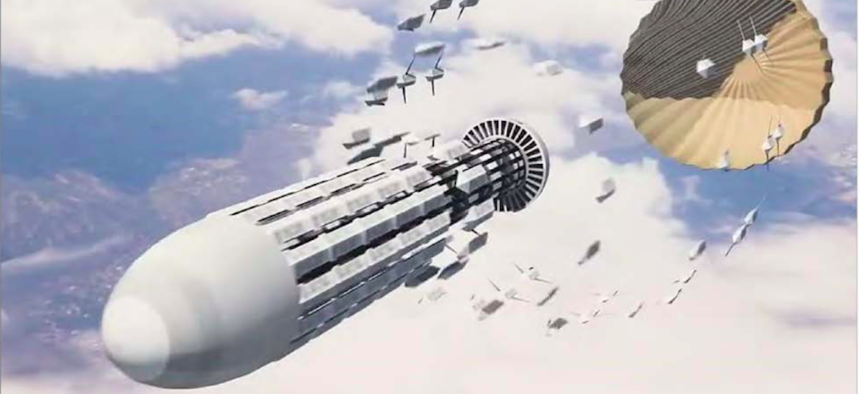
An Artist rendering of a next-generation drone swarm from the Air Force 2030 Science and Technology Strategy. US AIR FORCE
Air Force to Begin Shifting Research Funds to These Kinds of Next-Gen Weapons
The Pentagon’s continues to shift focus toward Moscow and Beijing with a new push for tomorrow’s drone swarms and smart missiles.
Taking a page from Silicon Valley, the Air Force has set up a new way to fund science and technology in the areas it sees as most important to the race with China and Russia. To lead the effort the military service branch will create a new chief technology officer position to oversee the development of next-generation capabilities, the Air Force announced on Wednesday at the unveiling of the service’s new science and technology strategy for 2030.
The Air Force funds lots of research, much of it on a small scale: a bit of money here to develop a new antenna capability, a bit there to teach drones to do a new trick, or a bit more there to create a new type of space-age material. The research sometimes makes its way into a formal program of record or an actual new weapon, but at the beginning of the process there is no way to know.
The change: Air Force officials say they are setting aside $560 million from it’s $2.8 billion science and technology budget to fund big projects, and all the little science and research efforts that go along with it. It’s similar to the way Google’s X Lab funds lots of different types of science and technology research around specific, big programs like flying cars or delivering broadband through balloons. In essence, it’s money to fund ambitious new projects from the ground up.
Right now, the Air Force has no specific idea what those big projects will be.
“The idea is to assess where our adversaries can’t easily go and get there first and fastest” Air Force Secretary Heather Wilson explained at a briefing for reporters. The service has established five research areas, which they’re calling “vanguards,” where they think they can “cause complexity for an adversary… not just [conduct] foundational research,” said Wilson.
Those areas are:
Global Persistent Awareness. That includes satellites and sensors but also edge computing capabilities that can “autonomously analyze sensor data at the source, accelerates the speed of intelligence processing, and reduce the demand on communications networks,” officials write, in the strategy document.
Resilient Information Sharing. For years now, the Air Force and other services have been advancing future fighting concepts that sound a lot like massive, weaponized nervous systems, with every drone, jet, and soldier digitally connected to everything else. Building that network has proven a bit harder. The Air Force is looking to build new networks that can “autonomously share data of different types and classification levels across the Joint and Allied Forces. They will adjust gracefully to degradation and reconfigure and change in spectrum, as needed, to maintain connectivity,” officials say.
Rapid, Effective Decision-Making. Remember how HAL 9000 was supposed to co-pilot and manage the ship in 2001: A Space Odyssey. The Air Force wants artificially-intelligent aids to help commanders and everybody else make decisions much faster. They’ll be aided by new research, not just in artificial intelligence and sub-domains like predictive analytics, but also the best way to get humans to interact with electronics and digital assistants.
It’s an area where the private sector is already sprinting ahead. But the Air Force can’t just crib off of what Apple is doing. A lot of the data that the Air Force uses comes from “unpredictable and uncertain physical environments, noisy and unstructured data from dissimilar sources, limited training data for machine learning, and the high levels of trust required to support lethal combat operations.”
Complexity, Unpredictability, and Mass. That means swarms, but also anything that can fight in the air that isn’t a $90 million-dollar jet with a human pilot. “Swarms of low-cost, autonomous air and space systems can provide adaptability, rapid upgradability, and the capacity to absorb losses that manned systems cannot,” they say.
*Speed and Reach of Disruption and Lethality. That includes smarter missiles, new hypersonics, next generation cyber tools and anything else you can think of to penetrate highly complex air defenses like the Russian S-400 anti-aircraft radar and missile battery, or whatever comes after it.
The Air Force already has a chief technology officer, but that position handles the Air Force’s information technology efforts. The newly created CTO position will serve as a sort of new technology czar, so the Air Force will have an information technology CTO in the Office of Information Dominance and one in charge of vanguard efforts.
Wilson couldn’t say when the new CTO would be on the job, only that she had already signed the memorandum creating the position.




